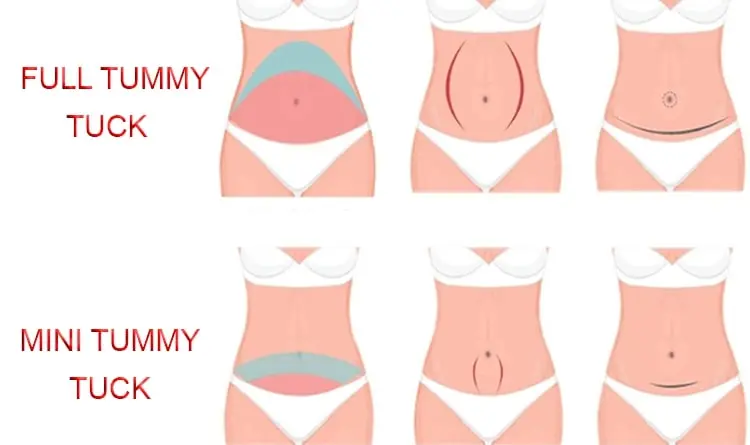Are Tummy tucks Worth Considering?
Are Tummy tucks Worth Considering?
What are the advantages of a getting a tummy tuck?
First and foremost, a tummy tuck is not a weight loss procedure. Instead, it is a « body contouring » method – it is not a solution to obesity but a way to help individuals who have lost weight and are left with excess fat and skin around their stomach. There are a number of reasons for why people choose to have a tummy tuck. One of the main reasons is that it has a very high success rate in patient satisfaction. In fact, a tummy tuck has one of the highest satisfaction rates of any cosmetic procedure. Studies have found that this is due to both the physical and psychological benefits of the procedure. In terms of physical benefits, a tummy tuck can offer a panacea to the problems faced by those who have excess skin around their stomach. By removing this skin, patients can experience an improvement in mobility and a reduction in skin conditions. Furthermore, a tummy tuck can give the stomach area a much more toned and tighter look, which is another appealing factor for patients. Psychologically, the benefits can be equally as impressive. The high satisfaction rate indicates that a tummy tuck is one of the most effective ways to boost body confidence and general happiness. Patients often report feeling much more comfortable in their own skin and having increased self-esteem and confidence. For people who have lost a significant amount of weight, a tummy tuck can present a fantastic way to celebrate the achievement and feel positive about the future.
What does a tummy tuck do?
When you gain weight, your skin must stretch to accommodate the extra fat. Unfortunately, skin is not always elastic enough to keep up with the changes in your body shape. For example, when you become pregnant, your abdominal muscles and your skin will stretch to accommodate your growing baby. However, for some women, their skin becomes too stretched, particularly if they have had a number of pregnancies, meaning it struggles to shrink back to its original size after childbirth. Significant weight loss can also result in loose, sagging skin in the abdominal area. This is because the skin has been stretched so much, often over a long period of time, that the elastic fibers have become damaged or weakened. This means the skin is unable to retract as your body becomes smaller. A tummy tuck aims to correct these issues by tightening the abdominal muscles and removing the excess skin, as well as fat, to provide a smoother and firmer profile. At the first appointment, your surgeon will discuss the results that you want to achieve and assess whether a tummy tuck is suitable for you. He or she will also talk you through the options for the anesthesia and the possible risks and complications of the surgery. In particular, they should be able to tell you the type of scar that you can expect after the operation. Most people will have a permanent scar, although this will usually be low down and below the bikini line. The chances of complications are higher if you have a lot of excess weight or if you smoke. Also, sometimes the operation may have to be carried out in two stages in order to minimize the risk of any serious blood loss.
How long does a tummy tuck last?
A full tummy tuck, also known as abdominoplasty, requires a horizontal incision in the area between the navel and the pubic hairline. The length and shape of the incision will be determined by the amount of excess skin. The surgeon will lift the abdominal skin to repair the muscles and confirm the amount of excess tissue to remove. The skin is then pulled down and the extra skin is removed. A new hole will be cut for the navel. Most tummy tuck operations take two to five hours. Any kind of surgery will leave a scar, but it will fade over time. The final results of tummy tuck surgery may be initially obscured by swelling and may take a few months to a year to fully diminish. With just a little maintenance on your part, the results of your tummy tuck surgery can last for years. When we refer to maintenance which will affect the longevity of the results, we mean maintaining a stable weight and general fitness. Weight gain and loss can have a big impact on your tummy’s long-term appearance. Women who may be considering future pregnancies are advised to postpone a tummy tuck because pregnancy can separate muscles that were tightened during the operation. Also, the vertical scar in the lower abdomen area and the resulting scar around the tummy tuck are likely to worsen, as it could affect the skin. By maintaining your tummy tuck longevity is achievable. However, the natural aging and the loss of the skin’s elasticity over time can decrease the lifespan for the abdomen to stay firm. And so at some point, the skin on the abdomen may become looser again. Most patients find best long-term results with a healthy diet and regular exercise to minimize the natural aging process.

What are the disadvantages of a tummy tuck?
The big consideration is cost. A tummy tuck can cost anywhere between £3,000 and £8,500. The costs can vary depending on the clinic and the exact nature of the surgery. Additionally, if anything were to go wrong, the patient may need further treatment to rectify the problem, which would incur extra costs. And because tummy tucks are deemed a cosmetic form of surgery, it is unlikely that the NHS will pay for the operation. However, if complications do arise due to the surgery, and the patient needs further medical assistance, then the NHS may cover the subsequent treatment. It is vital that the procedure is carried out by a qualified and registered surgeon. If it is not, or if the procedure is performed in an unregistered clinic, this will significantly increase the risk of the operation going wrong. Also, if anything were to go wrong during the surgery, it may be that further corrective surgical treatment would be necessary to rectify the problem. As well as the general risks of surgery – such as the chances of infection or complications from an aesthetic – a tummy tuck comes with other dangers, including a severe skin infection and a blood clot under the skin. It is likely that immediate side effects following a tummy tuck will include pain, swelling and bruising. In some instances, there may also be an emotional reaction. For example, it has been found that a small number of women will feel tearful and may even show signs of depression after the surgery. Furthermore, there are long-term risks to consider, such as scarring, which can be significant and unsightly, particularly if the patient is prone to keloid scarring. Also, there is a risk that the patient will be unhappy with the results of the operation, either because it was not carried out correctly, or because they have unrealistic expectations.
Is the tummy tuck painful? How long does it take?
The pain and discomfort would vary from patient to patient and to some extent depends on the extent of the tummy tuck performed. For a mini tummy tuck, pain is usually less, and the procedure typically takes about one and a half to two hours, followed by a short period of recovery. The pain after a mini tummy tuck should be comparable to a caesarean section. On the other hand, a full tummy tuck operation, which may take almost twice as long with more discomfort, would require a more significant recovery time. For most patients, the worst of the pain would have subsided after about three to five days, and would then gradually improve. However, full recovery may take up to three months. It is also noted that the newly formed scar, which would initially appear as a thin red line, would take up to two years to mature into a white line which would continue to improve over time. In terms of the surgery duration, a full tummy tuck generally takes about two to five hours depending on the extent of the surgery. And with a standard tummy tuck operation, the first incision is created, a second will be necessary to free the navel from the surrounding skin. It is then followed by the creation of a new navel and then the removal of excess skin and fat, and finally the skin is stitched back into place. All these explain why the standard tummy tuck could be time-consuming and prevailing. On the contrary, during a mini tummy tuck, a much smaller incision will be made above the pubic area, and therefore it would mean a faster surgery and less pain as well. From the duration point of view, a mini tummy tuck usually takes about one and a half to two hours. Every surgery entails having a conversation with the surgeon. However, the conversation must be realistic, and a patient should not expect a total pain-free procedure as undergoing a tummy tuck would mean that there would be some level of discomfort to be experienced.

